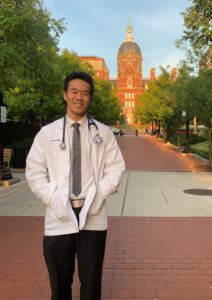Takeaway
I was nervous taking care of my first patient as a student on the medical wards. I felt more comfortable when I realized that even experienced clinicians don’t know everything, and of course they did not expect me to have all the answers.

Lifelong Learning in Clinical Excellence | August 18, 2021 | 2 min read
By Howard Chang, Medical Student, Johns Hopkins Medicine
I recently took care of my first patient as a medical student on the wards. She was a young woman with a classic case of community-acquired pneumonia. Any intern or resident would have likely considered this their “easiest” case of the day. But as I read her chart, I noticed that the cognitive burden for me was embarrassingly high. I tried to remember all that I’d learned from my Step 1 preparation about the most common pathogens causing community-acquired pneumonia and the appropriate antibiotics (if any!) to administer. I mentally rehearsed all the questions I would ask about her symptoms and imagined the mistakes I wanted to avoid in conducting the history and physical from start to finish.
As it turned out, I had no reason to worry. My intern offered to see the patient together with me, affording me the independence to try to do as much of the history and physical as I could. She stepped in only when I missed a critical question or glossed over a relevant portion of the exam. She gave immediate constructive feedback after we left the room. She had me write the entire patient note and offered recommendations on how to improve my note in preparation for my first oral presentation to the team. Most importantly, she was gracious, understanding, and instructive.
Most importantly, she was gracious, understanding, and instructive.
This experience helped me reflect on some key tips for how attendings and house staff might help medical students transition to the wards:
1.Offer an appropriate balance between independence and supervision.
By the time medical students start on the wards, they will have likely done plenty of shadowing already. Shadowing can still be helpful, particularly for more complicated cases, but I believe medical students should be allowed to do as much as is safe in the care of each patient. If a task makes me feel slightly nervous—but not afraid—it’s likely one that will help me grow as a clinician.
2. Be patient with learners as they make mistakes.
On my surgery rotation, I had to be taught several times how to handle the needle driver. I accidentally broke sterile technique, and cut a knot when I wasn’t supposed to. Failing at such basic skills embarrassed me, but my team used mistakes as teaching opportunities. Rather than scold me, they gently pointed out what I did wrong, what I should have done, and how I could succeed next time. I began making fewer mistakes and became increasingly more confident.
3. Engage learners by asking them questions and not expecting the right answers.
Medical students fear being “pimped,” which is being asked a question by an attending with a greater intention to judge the student’s competence than to teach the learner. Consider asking learners questions that challenge them to articulate their thought process rather than trivia-type questions that are either patently correct or incorrect. Always validate their efforts. Take advantage of students’ uncertainty—or false confidence—in answering your questions as valuable teaching opportunities.
If a task makes me feel slightly nervous—but not afraid—it’s likely one that will help me grow as a clinician.
This piece expresses the views solely of the author. It does not represent the views of any organization, including Johns Hopkins Medicine.

